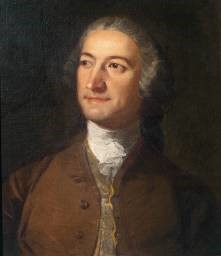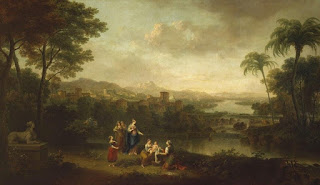Tuscan-born artist appealed to English tastes
 |
| Richard Wilson's 1751 portrait of Francesco Zuccarelli is at Tate Britain |
Francesco Zuccarelli, who was considered to be the most
important landscape painter to emerge from Venice in the 18th
century, was born on this day in 1702.
Zuccarelli’s picturesque Arcadian landscapes were especially
appealing to English buyers, and he was more famous in England even than his
contemporary, Canaletto.
His fame in England prompted Zuccarelli to spend two periods
of his life there. He settled in London for the first time at the end of 1752
and remained for 10 years, enjoying great success.
After returning to Italy after being elected to the Venetian
Academy, he went back to England from 1765 to 1771, during which time he was a
founding member of the Royal Academy and became one of George III’s
favourite painters.
Born in Pitigliano, a medieval town perched in top of a tufa
ridge in southern Tuscany, Zuccarelli received his early training in Florence,
where he engraved the frescoes by Andrea del Sarto in SS Annunziata.
 |
| The Finding of Moses (1768), commissioned by George III, is part of the Windsor Castle collection |
Zuccarelli’s father
Bartolomeo owned several local vineyards. With considerable income at his
disposal, he sent Francesco to Rome at the age of 11 or 12 to begin an apprenticeship
with the portrait painters Giovanni Maria Morandi (1622–1717) and his pupil
Pietro Nelli (1672–1740).
From around 1730 he was active in Venice, where he was influenced
by Marco Ricci and extensively patronised by British travellers and became
friendly with Richard Wilson, who painted his portrait. The art collector Joseph Consul Smith, the patron of Canaletto, became
his patron too.
He moved to London in October 1752, rapidly achieving
great success with his Italianate landscapes, which were probably less real
places than idealistic paintings of Italy, imagined as a country with
well-behaved peasants, delightful weather and pretty rural scenery. No other Italian painter in London in the 18th
century could match Zuccarelli’s success.
 |
| Zuccarelli's Bull-Hunting is housed at the Galleria dell' Accedemia in the Dorsoduoro quarter of Venice |
Zuccarelli designed a series of tapestries for Charles
Wyndham, 2nd Earl of Egremont at Petworth
House in West Sussex, now a National Trust property. He decided to return to
Venice late in 1761, holding a sale 70 of his works in February 1762 with the
intention of making his way back to Italy once all the works were sold.
He had achieved his goal by November 1762 and arrived in
Venice before Christmas. The following
year he became a member of the Venetian Academy but the demand for his work in
England remained high and he went back for a second stay in February 1965.
He received at least one commission from George III - Finding
of Moses (1768, Royal Collection).
Zuccarelli became a founder-member of the Royal Academy in
1768, exhibiting there from 1769-71 and 1773. He also exhibited at the Free Society
of Artists in 1765-6, and 1782, and at the Society of Artists in 1767-8.
He returned to Venice in late 1771, putting himself in a
position to be elected President of the Venice Academy the following year.
Shortly afterwards, he retired to Florence, where he died in 1788.
Despite the fame he experienced in his lifetime,
Zuccarelli's reputation declined in the early 19th century with naturalism
becoming increasingly favoured in landscapes.
Many of Zuccarelli's landscapes are in Windsor Castle, the
summer residence of Queen Elizabeth II, Consul Smith having willed his collection
to the English monarchy on his death.
 |
| Pitigliano in Tuscany, where Zuccarelli was born, appears to be carved out of the rock on which it sits |
Travel tip:
Pitigliano, which can be found about 200km (125 miles) south of Florence close to the border between Tuscany and Lazio, rises dramatically from a tufa ridge, the stone of its houses blending with the tufa as if
carved from the rock. The town is known as Piccola Gerusalemme - Little
Jerusalem - after the large Jewish population that settled there in the middle
of the 16th century, fleeing from the south to avoid the Vatican's persecution.
The town still has a synagogue, although very few of the current population of
just under 4,000 are Jewish. The Orsini Fortress and the former cathedral of Santi
Pietro e Paolo are among the attractions for visitors and some restaurants
still serve dishes with Jewish influences. The Orsini Palace Museum contains some of Zuccarelli's work.
 |
| The Ospedale degli Incurabili, current home of the Accademia di Belle Arti di Venezia |
Travel tip:
The Venice Academy of Fine Arts – the Accademia di Belle
Arti di Venezia – was first housed in 1750 in the Fonteghetto della Farina, a
flour warehouse and market on the Grand Canal near Piazza San Marco. In 1807,
it was moved to premises in the Palladian complex of the Scuola della Carità in
the Dorsoduro quarter, which today houses the Gallerie dell’Accademia, where a
number of Zuccarelli’s works can be found . The academy itself is now based at
the Ospedale degli Incurabili, also in Dorsoduro, looking out over the Giudecca
Canal.